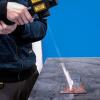Rust Removal with Laser Technology: efficient and sustainable

Rust has always represented one of the main challenges in the maintenance of metal structures, from small industrial components to large infrastructures. While traditional removal methods rely on abrasive and chemical techniques that are often invasive and potentially harmful, laser rust removal has revolutionized the sector by offering a precise, sustainable, and efficient solution.
Thanks to its ability to selectively remove oxidation layers without damaging the underlying metal, this technology is emerging as the new benchmark for professionals and industries seeking high-quality results while respecting environmental standards and operational safety.
What is Rust and why does It form
Rust is the result of a redox (reduction-oxidation) chemical reaction between iron, oxygen, and water. In the presence of moisture, iron oxidizes by losing electrons (Fe → Fe²⁺ + 2e⁻), while the oxygen dissolved in water gains these electrons, forming hydroxide ions. The final product of this process is hydrated ferric oxide (Fe₂O₃·nH₂O), commonly known as rust—a porous and unstable substance that flakes off easily, exposing fresh metal to further oxidation.
Metals susceptible to oxidation include primarily iron and steel, but materials such as copper, aluminum, and bronze can also exhibit different forms of surface oxidation. Corrosion occurs more rapidly in humid, salty, or acidic environments, which are common in many industrial and marine conditions.

Traditional technologies for Rust Removal
Until a few years ago—and now increasingly rarely—rust removal was carried out using invasive physical or chemical processes. The most common methods included abrasive brushes, sandpaper, rotary grinders, sandblasting machines, and acid-based deoxidizing chemicals.
While effective in certain contexts, these technologies have several drawbacks:
- they often damage the underlying metal,
- they produce hazardous residues and dust,
- and they require time, labor, and advanced protective equipment.

How does Laser Remove Rust
Laser rust removal technology uses a high-intensity beam to target the contaminated surface. Oxides, which have a higher energy absorption coefficient than metal, are rapidly heated until they reach their vaporization temperature. The underlying metal, on the other hand, tends to reflect the laser and therefore remains intact and unaltered.
This mechanism relies on the principle of thermal selectivity and operates within an extremely precise three-dimensional range known as the depth of field.
Within this range, the energy is sufficient to remove rust but does not penetrate or damage the metal. The result is a clean surface, preserved in its structural properties and free from chemical contaminants or abrasive residues.

Advantages of Laser Rust Removal compared to traditional methods
Using laser technology for rust removal offers benefits that no other method can provide simultaneously:
- No physical contact with the surface, meaning zero wear and no mechanical damage,
- Micrometric precision and complete control over removal depth,
- Total elimination of chemical substances and consumable materials,
- No toxic dust and full environmental compliance (green technology),
- Easy automation on robotic lines and adaptability to complex surfaces.

See our Products
Applications and versatility of the Portable Laser Rust Remover
Portable laser rust removal systems are ideal for on-site maintenance operations. They are widely used in areas such as:
- Automotive industry (frame restoration, components, tools),
- Naval and railway sectors,
- Maintenance of industrial plants and metal structures,
- Architectural restoration and cultural heritage preservation.
Using a laser device for rust removal is a practical and efficient solution to reduce operational time and costs, eliminating the need for disassembly or transport to specialized facilities.
These portable systems stand out for their ease of use, high safety standards, and compatibility with even sensitive industrial environments.
Watch the Video on Youtube
In the video, you can see a laser rust remover in action. The beam flows smoothly over the metal surface, instantly removing the oxidized layer and revealing the shiny, perfectly preserved substrate underneath. It is the visual proof of the precision and effectiveness of this technology.
How much does a Laser Rust Removal system cost?
The cost of a laser rust removal system depends on several factors, including:
- the power (Watt) of the source,
- the type of optical scanner,
- and the portability of the device.
Prices start from several tens of thousands of euros for high-power industrial systems.
In return for the initial investment, the economic return is quick due to the drastic reduction in consumables, processing time, disposal costs, and safety-related risks.

Why use Laser to Remove Rust
Laser rust removal technology is now the go-to solution for those seeking a fast, precise, sustainable, and cost-effective method.
Unlike conventional methods, laser rust removal does not damage the surface, leave residues, or cause pollution.
It is a key tool for industrial, artisanal, and restoration sectors that wish to improve the quality of their work and reduce their environmental impact.


